Far from being the sole appanage of religious narratives, the concept of the Apocalypse has been adopted by mainstream culture. In 1995 already, philosopher and semiotician Umberto Eco said: «Everyone plays with the ghost of the Apocalypse and at the same time exorcises it. The thought of the end of time is today more common in the secular world than in the Christian one.” The Apocalypse has thus become a concept through which we conceptualise our anxieties about existential threats and about the future in general.
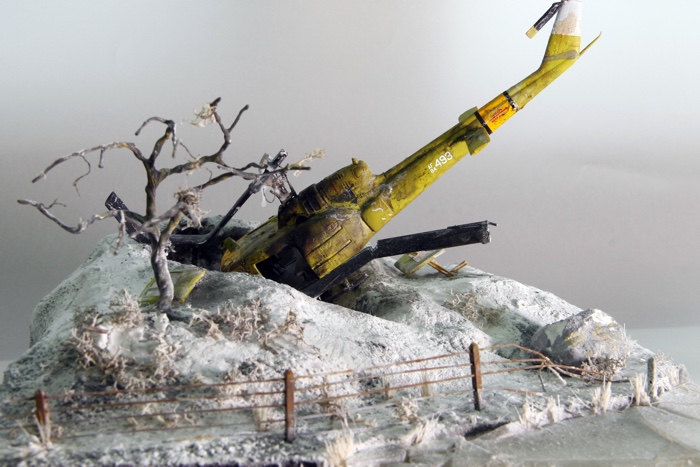
Andy Gracie, MICROPALYPSE_V1
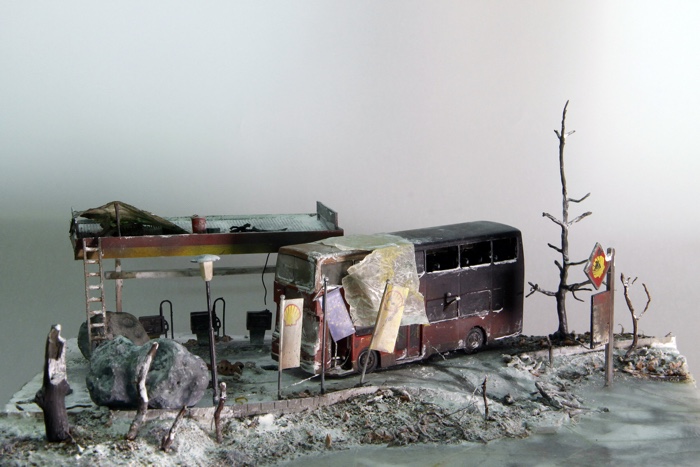
Andy Gracie, MICROPALYPSE_V1
The Haunting, by Andy Gracie, confronts head-on the inevitable end of the world. His series of installations talks about premonitions of disaster. It speaks of apocalypse fetishism and deep rooted fears. It speaks of deep time, impermanence and the liberation of losing control.
The Haunting series is articulated around several “chapters”. Catastrophe Jangled Hideously Out of Process presents an AI-vision of disaster based on images of disasters from the recent years – tsunamis, hurricanes, earthquakes, landslides, plane crashes, wildfires and war. The result is horrific, strangely alluring but also ironic when you remember that some see in AI a possible agent of humanity’s impending doom.
Micropalypse are models that propels the viewer into a post-apocalytic landscape. Conceived as sets for a proposed live cinema performance, the dioramas portray the aftermath of an unknown catastrophe that seem to have wiped out all life on Earth. Even more eerie and sinister, the scenes from Micropalypse Modular allow us to contemplate in detail the ‘world made strange’ that gives some of us a kind of “dark thrill.” A kind of new Sublime that has obliterated its human spectator.
Andy Gracie, The Ends of Everythings
The chapter in The Haunting series that affected me the most is The Ends of Everythings. The trilogy project develops narratives around the heat death of the universe. First, the Solar System. In some 500,000,000 years the Sun expands and consumes the Earth, spitting its atoms back out into space. Then comes the End of the Galaxy when the gravitational forces between the members of the Local Group cause them to merge and form a giant elliptical galaxy where star formation is no longer possible. Finally, the End of the Universe when even energy has disappeared.
The unavoidability of an end coming from outer space might seem like a consolatory distant prospect and it might even be refreshing to know that it won’t be our fault, for a change. The idea of the ultimate end of the universe puts our own existence into a stimulating perspective: we’ve been part of Earth history for a fleeting moment and Earth itself occupied just one tiny section in the history of the universe. Still, contemplating the “ends of everythings” gave me vertigo.
Andy Gracie, Micropalypse Modular
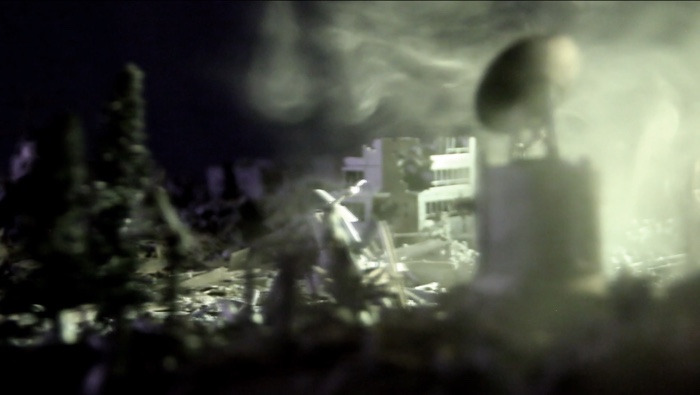
Andy Gracie, Micropalypse Modular
I wondered what would make an artist want to contemplate the idea of a world devoid of any hope and human breath:
Hi Andy! Of all the works in The Haunting series, the one that moves me and disturbs me the most is The Ends of Everythings. The project develops narratives around what is generally agreed to be the end of the Universe – the phenomena known as ‘heat death’. The first time i heard about the end of the solar system, my first reaction was “Who cares? It will take place in some 500,000,000 years. We won’t be there” but then I felt uneasy. I still am. Why do you think we care so much about an event none of us, none of our children, grandchildren or great-grandchildren will ever experience?
I’m not sure if ‘care’ is the right word. I think there is a common feeling of horror and an incredulity towards the idea that a time will come that the human race does not exist. The human brain seems to be hardwired into the notion of permanence – the idea that things will remain the same – and we find it incredibly difficult to imagine all that surrounds us not being there. However, when we attempt to adjust our thinking towards deep future timescales then we are forced to realise that this illusion of permanence that makes our daily lives possible is actually just a very brief moment within a very fluid system.
This of course, applies mostly to those of us in the ‘developed’ world. For the first time those of us in the privileged world are having to consider a process of rapid change and the stark possibility of losing many of the comforts and stabilities which are are accustomed to. So in many ways the contrasting experiences between those who already assume disaster as an inevitability and those who are in denial that it can happen to them is a thread that is present in my thinking.
One of the overriding rhetorics is that of survivability, of looking for strategies to ride out the apocalypse, of looking to techno-utopian solutions, or to the science fiction fantasies and billionaire vanity projects of colonising other planets. I wanted to begin to look beyond that, to future scenarios that are in no way survivable, and to find out what mental strategies are necessary to deal with that.
I want to find out where the survivalist, prepper, escapologist, colonialist mindset begins to break down. We can imagine many ways in which the human race will survive disasters of increasing scales and therefore feel comfortable with some form of continuity. But there will come an inevitable moment when a line is crossed and there is no coming back. At some point in the future a generation of humans will understand that they are the last.
You are collaborating with the Institute of Cosmic Sciences in Barcelona about the end of the Universe itself. Can you tell us what the collaboration is about? And what your role as an artist is in this context? Is it purely about visualising the science behind a rather abstract (to most people) future?
In 2019 I approached the ICCUB with just an interest in finding out more about the research they do, and they suggested I make them some kind of proposal. As this was about the time I was beginning to think about this project that would deal with the end of the Universe I decided that this is what I would propose. And they were totally cool with it. There are no researchers there who work specifically on eschatological cosmology, but there are some who work on the mechanics of the Universe that help us to understand its future evolution and states. They are also at ease thinking about and discussing the vast scales of time and distance that are involved. And they also have a deeply philosophical form of thinking about the science they do and the way in which it helps us to understand the Universe, so we get into some very interesting conversations.
There are absolutely no expectations from them and my role is definitely not to visualise the science. Which is good. Due to the hiatus caused by the pandemic, the project has also taken on a kind of almost glacially slow pace of its own as well. Its a project that can not and will not be rushed.
What has been a great honour is that they have made me the official artist in residence and the Institute’s first ever official collaborative member from the arts world.
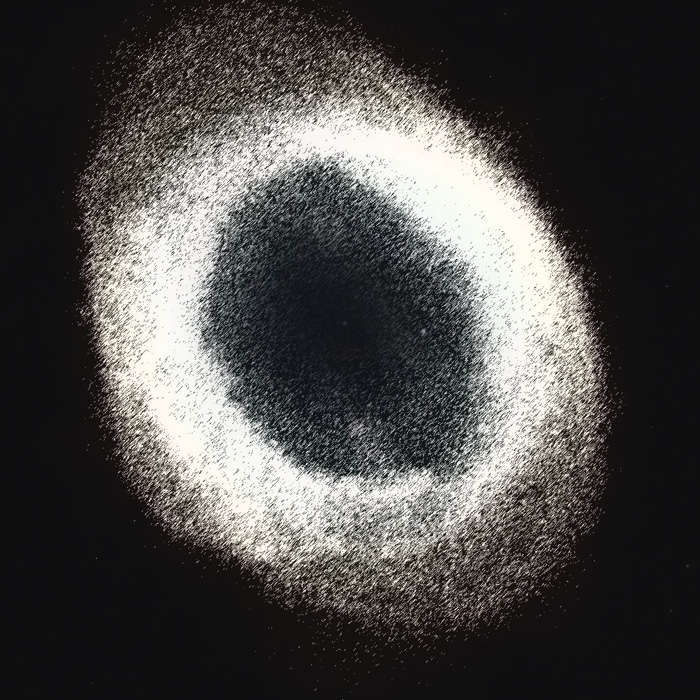
Andy Gracie, The Ends of Everythings
What is the impact of working for so long on the topic of the apocalypse? Does this research assuage your fears, amplify your anxieties or act as a catharsis?
I had this same excellent question when I did a talk about this work for the University of Santa Barbara. So yes… I do find myself bogged down from time to time and I do think that on occasion it has affected my mental state. That’s due as much to the reading I’ve been doing as the nature of the subjects themselves. I’ve learned that I need to intersperse my reading and research and practice with something lighter from time to time. However, there is also something weirdly liberating and empowering about facing up to the realities of what is happening in the world and what could happen.
I think it’s very important that we are more aware of our fragility and impermanence and that we strive to allow that humility to lead us to a more positive society. Carrying on in denial is going to bring disasters sooner, whereas by facing up to what is happening and could happen can bring us the strength to have honest and open discussion about it.
It is important to be able to disconnect from the work, but I think that is true for all kinds of creative work. As artistic types we can become very obsessive, and that is equally unhealthy whether you are making work about the destruction of humanity or practising the art of Japanese flower arranging. Fortunately, I’ve always been pretty good at disconnecting.
One of the fascinating psychological phenomena that I’ve come across is ‘compassion fatigue‘ which forms part of our coping and desensitizing mechanisms. It seems that a common reaction is that people will react to constant exposure to scenes of suffering and disaster by caring less.
And in general, is the series concerned with fleshing out current anxieties or giving shapes to your own?
I think what I’m trying to do, and I don’t claim to be sure about this, is to find out what my anxieties actually are. I have a constant desire to contextualise things, to see everything in the light of everything else. In this case, I wanted to take a step back from immediate climate anxiety rhetoric and to see if it still matters when everything ends anyway. So then a new anxiety begins to take shape about what, if any, meaning or purpose the very brief existence of humanity might have and whether we have time to realise it.
More fundamentally though, I guess, is that the anxiety I am giving shape to is my own in a pretty literal sense. The symbol of the Haunting itself is from a recurring childhood vision that suggested a fragile membrane between order and devastating chaos. I have to thank Kira O’Reilly for helping me to realise that the distant echoes of that sensation are behind my need to look more closely at external and internal anxieties related to existential threats.
Simultaneously I’m also trying to make some sense of anxieties on a more global scale, and what exactly those anxieties are a reaction to. Humans have been constantly exposed to suffering and disaster, and we’re probably the generations that have been least affected in that way. However, we are now beginning to face up to something much bigger and more final for the first time, so I’m interested in what shifts in consciousness and awareness might be happening because of that.
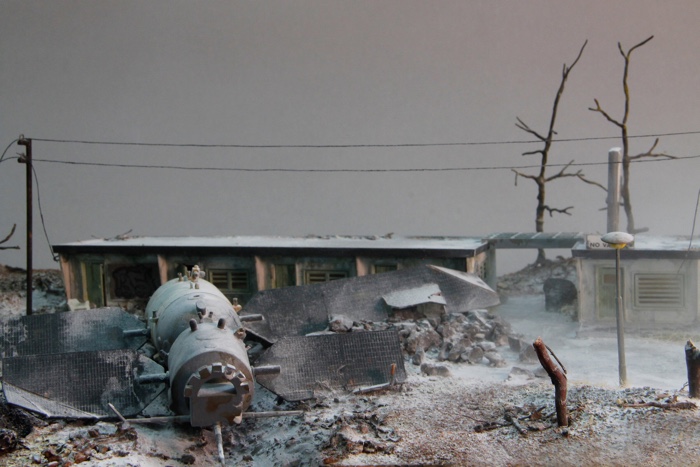
Andy Gracie, MICROPALYPSE_V1
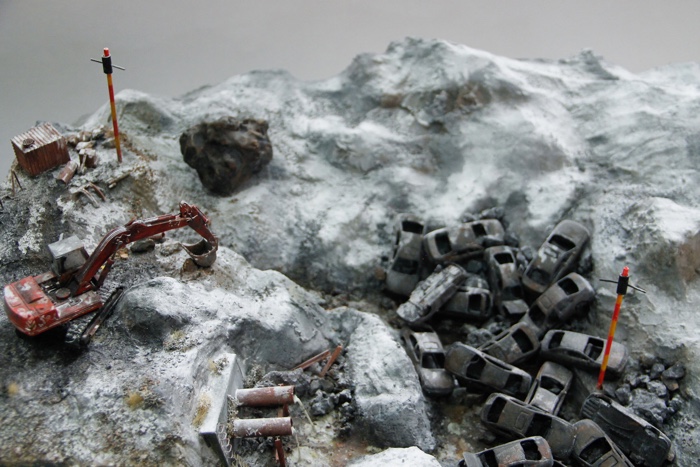
Andy Gracie, MICROPALYPSE_V1
At first, I wanted to see parallels between MICROPALYPSE_V1 and Jake and Dinos Chapman‘s Fucking Hell but I was wrong. As far as I could see, humans never appear in the works in The Haunting. Neither do other animals. Plants can be detected here and there but they are generally charred or decaying. Why this absence of anything we can identify as life? Why do your apocalypses appear so final?
I absolutely love the Chapman brothers’ dioramas and I would be lying if I said that they didn’t have some influence in some of these works. But you are right, the fundamental difference is that their work directly seeks to provoke discomfort and horror at human suffering and the human capacity for cruelty. In my works there is no human. As I’m sure you remember I have also sought to remove the human factor from the work that I make, being interested in how things work outside of human influence or in the absence of human presence. So the diorama scenes I have been making are definitely post human, or at least provoke an inquietude about where the humans and other life might be. They suggest that they are shortly after the humans have gone, and I was looking for that near future jolt of recognition that we get from films and books like Children of Men or The Road. Everything is familiar enough for us to place ourselves in it, we can relate, and therefore feel the anxiety of the dystopianism more keenly.
They appear so final because I am morbidly fascinated by that inevitable moment in time. There will come a time when there are no more humans living on planet Earth and there is absolutely nothing we can do to change that. I am less interested in the ideas behind those documentaries that show how ‘nature’ will begin to take over again than I am in ideas of loss and memory. I get the same feeling when I visit ruins of ancient civilizations. The feeling that things both important and mundane happened there and that the psycho-geography of the place has secrets that can be revealed. That the stories are still present, despite the absence of anything that created them. And then digging deeper down, to wonder whether what happened there had any significance or purpose.
I love the meticulous attention and craft behind MICROPALYPSE_V1. What was the inspiration behind it? Did you think about sci-fi movies? Newspaper images that describe real disasters and post-war landscapes?
I have always enjoyed making models and have thought for years about a way to incorporate it into my actual practice. I actually started making the first ones while I was stuck on another project, being a firm believer in the idea that thinking works better while your hands and brain are active. I quickly realised that the small dioramas I was making could form a series strong enough to stand on its own.
I wanted to portray images that were a mash up things we see in sci-fi and near future dystopian film with the kinds of images we see increasingly often in the news and on social media. They could have been drawings, or paintings, or digital collage, but they became dioramas and I think they are much stronger for that. I’m also much better at making realistic models than realistic drawings and it was important to me that they were as believable as possible.
The fact that they are made in the common hobby scale of 1:72, common in model making and model railways, gives them a certain recognisability while simultaneously generating a friction through the unusual subject matter and treatment.
The huge stock of reference images I amassed then became the material on which I trained the machine learning algorithm to make Catastrophe Jangled Hideously Out of Process.
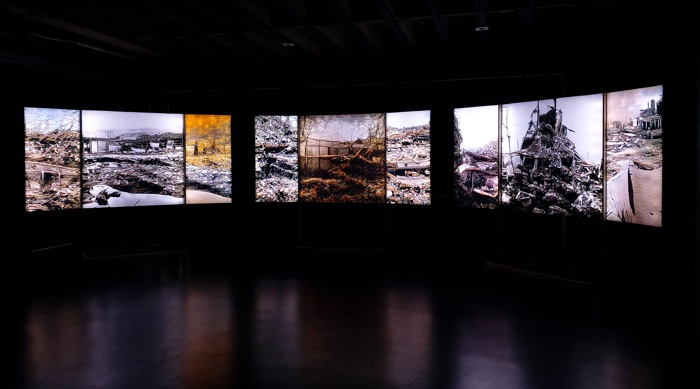
Andy Gracie, Catastrophe Jangled Hideously Out of Process
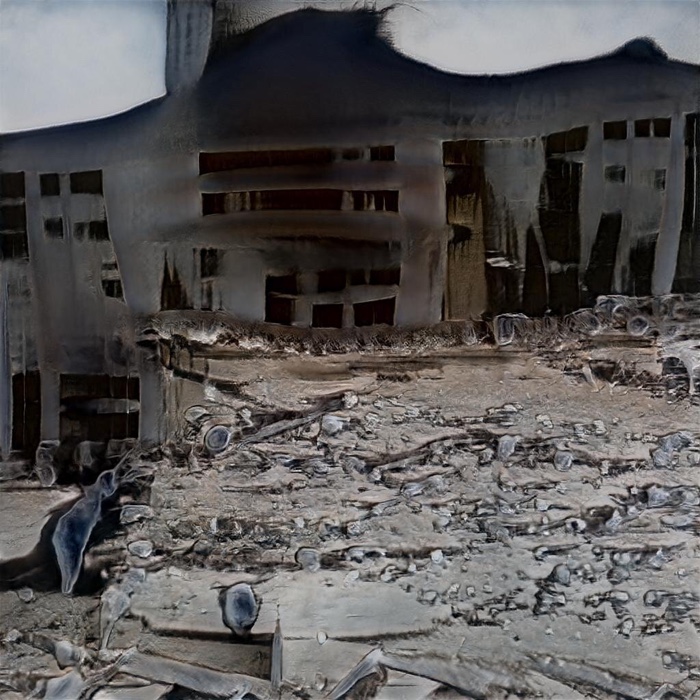
Andy Gracie, Catastrophe Jangled Hideously Out of Process
How big are the dioramas of MICROPALYPSE_V1?
Each one has a more or less A4 footprint, though dimensions vary a little, and as I mentioned above the scale is 1:72.
The Micropalypse Modular series is made in the next scale down 1:144 and features 9 modules of 60cm x 30cm… so far.
Thanks Andy!
